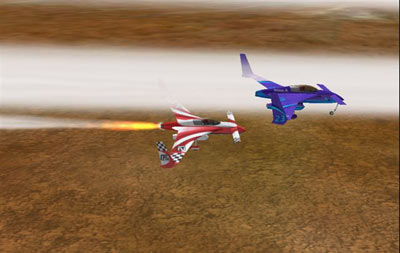Will rocket racing help us get into orbit?by Taylor Dinerman
|
| What the RRL rocket planes will do is to create a demand for such things as highly reliable and reusable rocket nozzles, turbopumps, and fuel systems. |
The Mark-1’s rocket engine will have a total burn time of about four minutes. Part of the skill of the pilot will consist of using that power, combined with the gliding characteristics of the aircraft, to fly around the course faster than the other nine competitors. The course will be equipped with virtual “gates,” so that each racer will stay safely in his or her own lane. The RRL hopes to connect the real races with virtual ones that kids can plug into using their PlayStations and X Boxes. This, they hope, will be a major profit center.
The league hopes that rocket racing will become the first big, new spectator sport of the 21st century. The big question is not whether this will make money or not (it probably will), but whether the impact of this effort will be more like modern motor sports or more like the Roman chariot races. Will there be newer and more powerful piloted rockets? Will these eventually become powerful enough to reach orbit? It would be nice to think so, but they have an awful long way to go.
The RRL’s Mark-1 will have a top speed of about 440 km/h—about a third of a Mach, nowhere near the Mach 25 escape velocity. By comparison, SpaceShipOne attained Mach 3.2 during its Ansari X Prize-winning flights. Obviously, there is an apples-and-oranges aspect to this comparison, but both craft can be called rocket planes and they both combine rocket-powered and unpowered flight. The point is that, even without pushing the envelope, there is a lot of room for the next versions of the X-Racer to improve.
The next versions will be designed not just with speed and altitude capability in mind, but with the need to give the paying public a spectacle worth watching. For example, NASCAR and other motor sports could, without too much trouble, reduce the roar associated with their racing cars, but a quiet Indy 500 would probably attract as many fans as a quiet rock concert. The RRL league will want to provide its customers with distinctive sounds and smells as well as with a fantastic visual experience. These requirements could get in the way of designing a machine that will push the technology towards real orbital capability.
| The greatest potential contribution that the new sport of rocket racing can make is to provide innovative small and medium-sized aerospace companies with an open-minded customer for their products. |
What the RRL rocket planes will do is to create a demand for such things as highly reliable and reusable rocket nozzles, turbopumps, and fuel systems. All of these technologies will be directly applicable to future space launch vehicles for both the private and government sectors. This sport will also demand better and better rocket engine control and health maintenance software. This will give young, independent software designers a chance to work on real-world rockets without having to join a major aerospace firm or to jump through the hoops needed to become a small size government contractor. For the sake of America’s future aerospace industrial base this could be the greatest value of all.
Truly creative people like Peter Diamandis, who we know as the creator of the X Prize Foundation and who is chairman of the RRL, do not fit into neat categories. The people who will supply the better subsystems and designs for the next generations of racing rockets are likely to be as unconventional and original as he is. These steps are not going be taking place at the “bleeding edge” of technology. Paying for such research would cut too deeply into the league’s hoped-for profit margins for it to be worthwhile.
The greatest potential contribution that the new sport of rocket racing can make is to provide innovative small and medium-sized aerospace companies with an open-minded customer for their products. This may not produce the big breakthroughs in reusable launch vehicles that leaders at the Pentagon and NASA have called for, but it could set the stage for them.
Since the collapse of the X-33 program it is clear that a frontal attack on the problem is probably too costly. Rocket racing, it seems, has the potential to contribute to the eventual success of an indirect approach. Since the goal of low-cost access to orbit is still an urgent national necessity, the case should be made that rocket racing is not just an exciting and spectacular new sport, it is also a profoundly patriotic endeavor.
